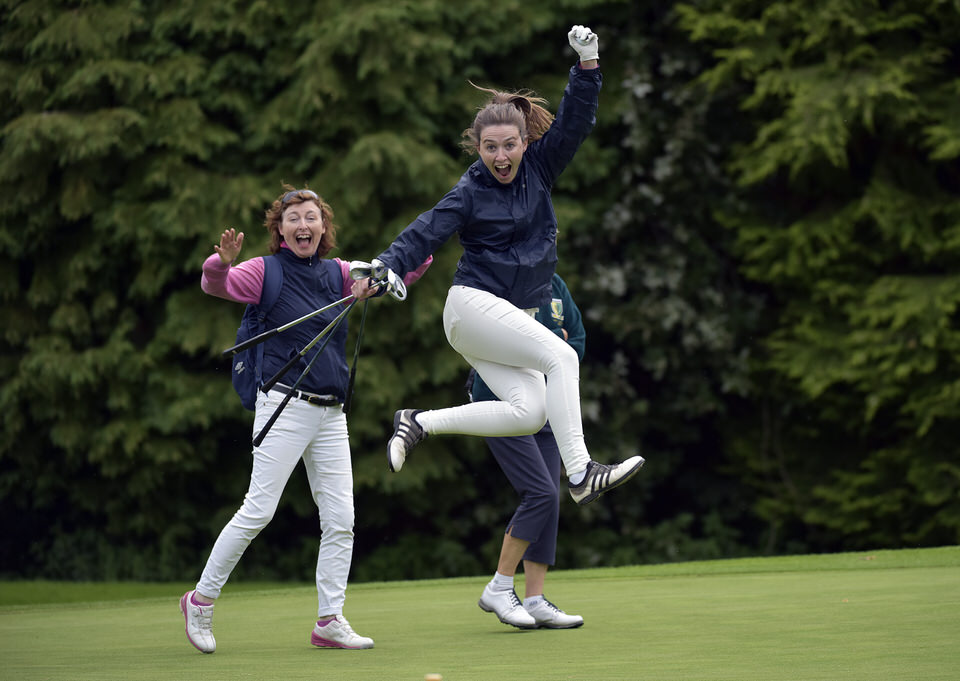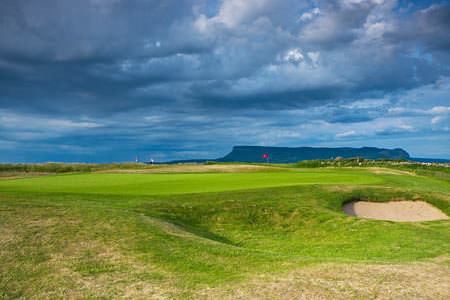Joining forces - Sinead Heraty and the future of Irish golf

Sinead Heraty and Martha Jones (Castle) celebrate on the 15th green victory in the Senior Foursomes Final at the 2015 AIG Ladies Cups and Shields Finals at Knightsbrook Golf Club. (25/09/2015) Picture by Pat Cashman
A new organisation will soon govern both men’s and women’s golf in Ireland and the ILGU’s CEO Sinead Heraty believes its formation is an ideal opportunity to do something special for the game on the island of Ireland.
James Thurber is best known for his short story, “The Secret Life of Walter Mitty.” He’s also written some wise and amusing things about men, women and even dogs.
Leaving aside our canine friends, he might have found the proposed formation of a golfing body for both Irish men and women to be a fascinating project.
“Somebody has said that Woman's place is in the wrong,” Thurber wrote. “That's fine. What the wrong needs is a woman's presence and a woman's touch. She is far better equipped than men to set it right.”
The Golfing Union of Ireland (GUI) was established in 1891 and was the first national golfing union to be established anywhere in the world. Similarly the Irish Ladies’ Golf Union was founded in 1893 and is recognised as the oldest Ladies Golf Union in the world.
Little wonder then that a great deal of thought is going into the inevitable formation of one governing body for male and female golfers on the island of Ireland.
And given the great character of the women’s organisation, its vibrant districts and strong volunteer base, it can only be a good thing for the men that they will have a major say in the running of the game for all.
For now, the ILGU and the GUI have only agreed to talk about having talks as the men still have to tidy up some governance issues and appoint their first CEO to replace the current role of General Secretary.
There’s no huge rush to get this done though ideally, it will be in place when the World Amateur Team Championship come to Ireland in 2018.
The respective men’s and women’s governing bodies became one in Wales in 2007 with England following suit in 2012. Scotland will follow suit on October 1st next by giving birth to the slightly unromantic sounding Scottish Golf Limited by merging the Scottish Golf Union with the Scottish Ladies Golf Association.
Whatever about what’s gone before, Ireland’s new body will not be a merger as far as the ILGU’s dynamic chief executive, Sinead Heraty is concerned.
“It is not a merger,” says the woman who has overseen the transformation of the ILGU over the past decade. “We will be doing something quite different than was done in England and Wales, or Scotland later this year.
“We have concerns about some of the things that have happened and being the last of the four Home countries to look at this, we have been observing what has gone before. Hopefully we will avoid some of the pitfalls.”
In an age when women’s sport still struggles for recognition, there are fears that the women will lose their voice and their identity in the male dominated world of sports governance.
But given that Irish golf introduced equality in golf clubs in 2000, a decade before its English, Welsh and Scottish counterparts, the road should be smoother here.
“The issues have been more or less thrashed through here over a long period of time,” Mrs Heraty says, adding that her concerns relate to the formation of the board of the new organisation and the recruitment of top women.
“The biggest concern is the voice of women’s golf and the profile of women’s golf and the coverage of it,” she says. “We have to promote women into the organisation, put women into senior management and senior decision making positions within the new organisation.
“It is no different than any other board of any voluntary organisation. What is the gender divide within boards of any company and it is very hard to recruit or encourage women to go into a male dominated society.
“It is not that there are not capable women out there. There are lots of them. But when they see the culture of an organisation as being very male dominated, they decide they don’t want to put themselves through that.
‘So when we and the GUI talk about it, we talk about a new organisation. If you were doing this from scratch in a modern Ireland, how would you approach it. The great thing for both organisations is that their ethos is— ‘What is best for the sport? What is best for golf on the island of Ireland?’
“Then you start to break it into chunks. But if your objective is what is best for golf on the island of Ireland, you will make the right decisions.”
Boosting the number of girls playing the game is a major goal and over the past decade, the ILGU has managed to double the number of girls actively playing the game.
Yes, total participation numbers plummeted during the financial crisis, but as the ILGU’s leader points out, the majority of those who gave up the game were women who joined with their husbands during the boom and had no handicap or a handicap of 36.
“I look at golf club membership and predominately the city clubs are doing very well,” she says. “Most of them have recovered. But ‘country’ clubs reflect the economy as a whole. Where Dublin is starting to boom again, the rest of the economy is not recovering as quickly. Plus there’s the fact that the population has also moved towards the eastern seaboard.”
The huge number of clubs offer low cost membership is also a sign of oversupply but there is low demand in an era when lifestyles are changing rapidly.
“It is not just the time element,” she says. “This is is the technology age and the way we do things is very different now. Golf has changed too.
Sinead Heraty
“You can see how life has changed just by looking at the Dublin Horse Show recently. People are not going in the same numbers. The days when the entire nation seemed to watch the Nations Cup on a Friday are gone. The whole area of sport has changed.”
The scheduling of events has also changed and while many struggle to understand why you would merge the Ladies and Girls Interpros and have them clash with the European Ladies Team Championship, it actually helps bring more players into the game.
“We took the top 12 players out of the Interpros and the review of it is that it has been successful for a number of reasons.
“First of all it strengthens Connacht. But it also gives the next fleet of players an opportunity to shine. They get the opportunity to go out and play against some of the older players and represent their province and play at that level.
“The younger girls see the older girls playing and the standard they are playing to. So it has actually worked very well. You always have the argument that you are not getting the top players into the Interpros. But then you are back to the argument, should the top players be playing interpros at all.
“The view is that we are broadening the base. We are trying to get more girls playing and that’s been reasonably successful for us. There are more girls playing golf than before.
“The number has risen from 1,000 to 2,000 girls actively played the game. It’s a very broad figures but it’s a good one.”
European Golf Association statistics claim that Ireland had 60,000 women golfers in 2007 and now has 37,000. But the figures are deceptive, Heraty says.
“We never had 60,000 playing members. There were 52,000 handicaps and the dominant portion were 36 handicap or no handicap - in others words, women who joined clubs with husbands or partners during the boom.
“Around 85 percent were 36 handicap or no handicap. And if a person is a member of a club and not active, you are going to lose them when times are tough.”
Role models help the promotion of the game and get the general public interested and just as Padraig Harrington, Graeme McDowell, Rory McIlroy, Darren Clarke and Shane Lowry are role models for the boys and men, Ireland now has top women golfers to admire, such as LPGA player Stephanie Meadow, world amateur No 1 Leona Maguire or top junior star Olivia Mehaffey.
“It’s huge to have someone like Leona as world amateur No 1. And it would be huge to have her play in the Olympics with Stephanie. We underestimate the impact that something like that can have.
“Girls look at a Leona or an Olivia or a Stephanie Meadow and think, if they can achieve that, I can too. It is about creating those opportunities for girls. The good thing about the likes of Leona and Lisa and Stephanie is that they are very accessible to us. They will do anything we ask them to do.”
Media coverage of women’s golf and women’s sport in general is way below where it deserves to be and Heraty is determined to work to redress the balance.
“They are getting a reasonable amount of coverage but females sport in general needs more coverage,” she says. “When Leona finished second in the British Masters on the Ladies European Tour, the headline was about the New Rory. Even when Stephanie was third in the US Open, it was the new Rory again.
“Females sport in general is not respected and you heard the chicken and egg with people telling you that the public don’t want to read it. Well if you don’t print it, they can’t read it. Even Katie Taylor hasn’t had the level of coverage she should have received.”
Heraty is certainly excited about the future and the chance to draw on the best of both world’s to create an even stronger Irish game.
“I think all the research shows that mixed gender organisations are better because they bring a better mix of skills and better diversity,” she says.
“So while he have to be cognisant of the fact that both the GUI and the ILGU have existed for the best part of 120 years, we reflect the traditions and the times of the 1890s when we were set up.
“The environment we are operating in now very different and you have women and men on both sides that have very good skills and competencies.”
This article was first published in the September 2015 issue of Golfing Magazine







